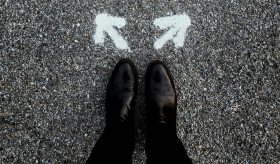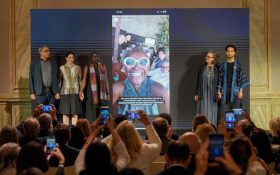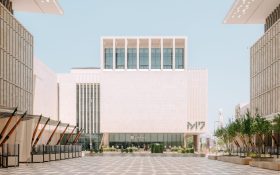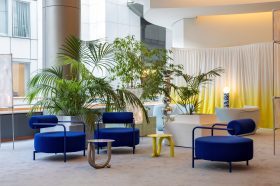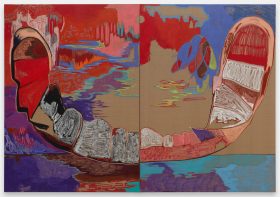British sculptor Richard Wentworth is currently working and exhibiting in the divided city of Nicosia, the capital city of Cyprus. Nicosia’s cultural life has recently been in the news with the recent dramatic collapse of the international Manifesta biennale, which was to have occurred in the city this year. Wentworth’s practice is always very closely related to the place where he is working – and he shares his insights into making art in this socially and politically complex location with British journalist Michele Witthaus.
When British sculptor Richard Wentworth received an invitation to spend several months making art in the divided city of Nicosia, Cyprus, he seized the opportunity to work in a completely different environment from his native north London. The result was an engaging exhibition of new pieces that speak volumes about the complex nature of the location – and of the artist himself.
Everyday objects from urban environments have always been central to Wentworth’s art. His working method usually involves extensive exploration of a particular locale to find objects to integrate in his pieces. A sense of place, evoked through the transformation of found artefacts, is integral to the finished sculptures. Much of his work has explored British locations, turning up new meanings through the juxtaposition of everyday industrial objects. Yet once he had settled into life in the capital city split down the middle into Greek and Turkish communities, Wentworth was surprised by how much at home he felt.
Nicosia is bisected by the Green Line, a demilitarised zone maintained by the United Nations since 1963. Until 2003, it was not possible to cross from one side of the city to the other; now, there is limited access at various crossing points. ‘I saw Nicosia as a stimulant,’ says Wentworth. ‘I think it is a very odd place – it reminds me a little of Israel in the mid-80s. I picked up little bits of cultural texture and was reminded of the banality of my own codes.’
He was struck by ‘a deep sense of the binary, which is very powerful there. It’s agrarian, slow and gracious. There are some old-fashioned courtesies attached to Middle Eastern melancholy: people say, “Come in, I’ll make you a coffee”.’
Wentworth’s stay culminated in an exhibition of the work he had made in the contemporary gallery run by his hosts, the Pharos Trust. Many of the pieces in Wentworth’s show juxtapose similar household objects found on either side of the Green Line. ‘Because I am English, there are 10 words for everything,’ explains Wentworth. ‘So I’m a sucker for a thing that’s the same as another thing but has a different name. For instance, there’s not more than half a mile between the people who made two water jugs I used in a sculpture, but these people live on opposite sides of the city’s Green Line. The overstated baroque version is Turkish while the very serviceable and more sensible cylinder is Greek Cypriot.’
In another work, Wentworth immediately subverts this notion of “we’re all the same, actually”. Two cone-shaped objects fashioned from cheap aluminum hang side by side from the ceiling, but these objects do not serve the same purpose at all. (One is a loudspeaker and the other turns out to be a device for holding chickens in place for slaughter.) So the artist reminds us that complacency about our similarities can mask differences that we overlook at our peril.
So how do the local Cypriots respond to Wentworth’s use of their detritus for his art? Typically, the reaction is one of scepticism about his interest in objects that, to many of the younger generation in particular, are outmoded and useless. At a talk given by Wentworth during the run of the Nicosia show, a local woman challenged his reworking of old bits and pieces, remarking that her father’s office (to her embarrassment) was full of the same kinds of humble, well-used objects. Wentworth confessed: ‘I’d probably love your father’s office. I like things that have a life. I don’t like the idea that something is “box fresh”. I bought a camera recently and found its newness rather disgusting.’
The brief for the residency was flexible and generous, remarks Wentworth. ‘No promises were made regarding what would happen during my stay. Garo Keheyan, who runs the Pharos Trust, knows I can work rather like some people can sing to order. I can respond to a situation.’
Wentworth likes the concept behind artist residencies and retreats: ‘It’s the idea that artists would be much better if taken off the running board of their daily lives.’ He notes that there has for centuries been a class of people who have helped artists to move around – an enabling class. ‘People in this relationship are placing bets on each other. It’s quite a tender thing as a result – nobody wants it to fail. I think one should not underestimate how much diplomatic work is involved. Each person has their expectations: “This person will do this for me”.’ The key to success in this situation, he says, is to recognise when something is within your risk threshold and act upon it.
The idea of the artist being inherently foreign or intruding on an existing order comes up frequently in conversation with Wentworth. ‘I prefer not to be able to speak the language. I’m interested in why things are the way they are. I am an amateur etymologist but I don’t necessarily need to know the name of everything.’
Artists need to know what stimulates them in order to orientate themselves in the world, says Wentworth. For him, stimulation comes through exposure to “brokered experiences” which force him to confront strange, confusing and even unpleasant things. ‘I quite like the idea that it might be ghastly.’ He likens his approach to something that happened when his son, then eight, was throwing objects from the beach into the water. ‘He picked something up and realised it was dogshit. I still recall his fabulous change of expression.’
Going for a walk with Wentworth illustrates this ability to be moved by the curious and the discarded. We were on our way to a restaurant located near to the ancient walls of Nicosia’s atmospheric and crumbling old town. With characteristic casualness, Keheyan led us in via a dark alley and through the kitchen. Near the back door, Wentworth paused and exclaimed: ‘Oh, that is just beautiful!’. We turned to look. He had spotted a bag full of cement that had been placed as a makeshift step between the street and a doorway. Torn and sagging in the middle, the bag nonetheless functioned perfectly in its temporary role. Next to it, a piece of picket fencing held the door open. On the left of the doorway, a broom rested, serving no apparent purpose other than as a reminder of the Cypriot habit of perpetually sweeping the patch of street outside a house or place of business. We paused to gaze on this unassuming tableau while Wentworth took a photograph of what could have been one of his own installations.
Much later that night, we stood on the rooftop of a disused shoe factory located almost on the Green Line, gazing across into Turkish territory and sipping Zivania, the local firewater. Wentworth mused, ‘I don’t know what happened, but we are not the same people we were at 6 o’clock this evening. Everything is always changing.’
Inevitably, in a city fraught with old tensions and new challenges, not all change is for the better. During Wentworth’s stay, the heightened political milieu of Nicosia exploded in the chaotic collapse of Manifesta 6, the European Biennial for Contemporary Art, due to take place in the city from September. The Netherlands-based International Foundation Manifesta (IFM) and local officials in Nicosia had agreed to run an art school on both sides of the Green Line; in practice, the city officials dug their heels in on this issue, leading to the cancellation of the event. More than 100 young artists and writers from all parts of the world were to have taken part.
Wentworth was deeply upset by the loss of Manifesta, a roving exhibition that seeks to create venues for art in European countries that will lend their own, site-specific qualities to the project. The plans to unite north and south Nicosia for the duration of the biennial were close to the heart of Wentworth’s own practice, which draws together elements of disparate cultures. He is painfully aware of the rootless privilege of being part of the global cultural community.
‘We’re the oddest people ever – we can turn up for an hour at a gallery, which could be in LA, Stockholm or anywhere.’ Or even Nicosia – and Wentworth’s work, produced in this puzzling and often frustrating city, testifies to his understanding of the contradictions of the place as revealed in its objects and its rituals. A final analogy: Wentworth drained his drink and laid the empty glass down on its side. ‘There is a funny code governing what we do with things,’ he remarked. ‘Placing it like this is somehow “not right”. A lot of what I’m doing is finding things like this that are out of code.’ In the process, he reveals truths we might never have seen without his whimsical meddling.
Brief biography of Richard Wentworth
Born in 1947 in Samoa, Wentworth studied at Hornsey College of Art, London, from 1965, and worked with Henry Moore in 1967. He studied at the Royal College of Art, London between 1968-70. Wentworth was awarded the Mark Rothko Memorial (1974) and the Berlin DAAD Fellowship (1993/94). He taught at Goldsmith’s College, London, from 1971 to 1987, worked in New York, and is now Master of Drawing at the Ruskin School of Art in Oxford.
About the Pharos Trust
The Pharos Trust is a non-profit cultural and educational foundation dedicated to the promotion of a wide range of activities in the fields of the humanities and the arts. The Trust serves as a platform for substantial cultural exchange between Cypriot and international culture. Garo Keheyan is the Founder and President of the Pharos Trust. In 1978 he completed an MA in English Language and Literature from Lincoln College, Oxford University and an MA in International Relations from the University of Southern California. In 1980 he received an MBA from the John E. Anderson Graduate School of Management, University of California, Los Angeles.
